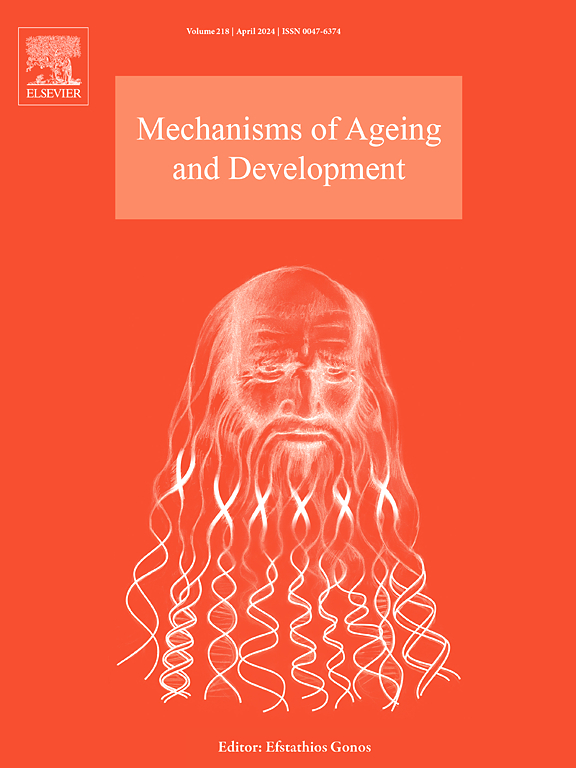p53/HIF-1α regulates neuronal aging and autophagy in spinal cord ischemia/reperfusion injury
IF 5.1
3区 医学
Q2 CELL BIOLOGY
引用次数: 0
Abstract
Objection
Spinal cord injury (SCI)-induced hindlimb dysfunction affects the physical and mental health of patients. There is growing evidence suggesting that the recovery capacity of elderly SCI patients is poorer than that of young individuals. However, the specific molecular mechanisms remain unclear.
Methods
RNA expression profiles of SCI samples were collected from the GEO database, and key genes involved in the progression of SCI were identified by the limma package in R software. A diagnostic model based on SCIDEG was constructed using LASSO regression analysis. Subsequently, correlation analysis was conducted to identify biological pathways influenced by the key genes. Furthermore, SCI animal models were established in different age groups to examine the expression of relevant genes and verify the molecular mechanism of p53/HIF-1α axis.
Results
We initially identified 34 ischemia-hypoxia-related genes potentially involved in the progression of SCI. Subsequently, we constructed a diagnostic model based on SCIDEGs using LASSO regression analysis. This model highlighted 9 key genes (TP53, SFTPA1, MASP2, KRT14, IL9, HIF1A, HGFAC, FUT7, and ALPP), which demonstrated high diagnostic accuracy in both the training set (AUC=1) and the validation set (AUC=0.855). Further cross-analysis with ischemia-reperfusion-related datasets confirmed the involvement of HIF1A and TP53. We also observed significant enrichment of HIF1A in organoids composed of mature neurons, which induced neuronal damage. In subsequent spinal cord injury animal models of different age groups, we found that HIF-1α expression was downregulated in the spinal cord tissues of elderly animals. Additionally, we discovered that TP53 activation induces cellular senescence in aging neurons and suppresses HIF-1α expression and autophagy levels within these cells.
Conclusion
In summary, our study suggests that the p53/HIF-1α signaling pathway plays a critical role in regulating neuronal aging and autophagy in the pathogenesis of SCI. Importantly, HIF-1α may represent a promising therapeutic target for SCI treatment.
p53/HIF-1α调节脊髓缺血再灌注损伤中神经元的衰老和自噬。
反对:脊髓损伤(SCI)引起的后肢功能障碍影响患者的身心健康。越来越多的证据表明,老年脊髓损伤患者的恢复能力比年轻人差。然而,具体的分子机制仍不清楚:方法:从 GEO 数据库中收集 SCI 样本的 RNA 表达谱,并利用 R 软件中的 limma 软件包确定参与 SCI 进展的关键基因。利用 LASSO 回归分析构建了基于 SCIDEG 的诊断模型。随后,进行了相关性分析,以确定受关键基因影响的生物学通路。此外,我们还建立了不同年龄组的 SCI 动物模型,以检测相关基因的表达,并验证 p53/HIF-1α 轴的分子机制:结果:我们初步确定了 34 个缺血缺氧相关基因可能参与了 SCI 的进展。随后,我们利用 LASSO 回归分析构建了一个基于 SCIDEG 的诊断模型。该模型突出了9个关键基因(TP53、SFTPA1、MASP2、KRT14、IL9、HIF1A、HGFAC、FUT7和ALPP),在训练集(AUC=1)和验证集(AUC=0.855)中均表现出较高的诊断准确性。与缺血再灌注相关数据集的进一步交叉分析证实了 HIF1A 和 TP53 的参与。我们还在由成熟神经元组成的器官组织中观察到 HIF1A 的明显富集,这诱发了神经元损伤。在随后不同年龄组的脊髓损伤动物模型中,我们发现老年动物的脊髓组织中 HIF-1α 的表达下调。此外,我们还发现 TP53 激活会诱导衰老神经元的细胞衰老,并抑制这些细胞中 HIF-1α 的表达和自噬水平:总之,我们的研究表明,p53/HIF-1α信号通路在SCI发病机制中调节神经元衰老和自噬方面起着关键作用。重要的是,HIF-1α可能是治疗SCI的一个有前景的治疗靶点。
本文章由计算机程序翻译,如有差异,请以英文原文为准。
求助全文
约1分钟内获得全文
求助全文
来源期刊
CiteScore
11.10
自引率
1.90%
发文量
79
审稿时长
32 days
期刊介绍:
Mechanisms of Ageing and Development is a multidisciplinary journal aimed at revealing the molecular, biochemical and biological mechanisms that underlie the processes of aging and development in various species as well as of age-associated diseases. Emphasis is placed on investigations that delineate the contribution of macromolecular damage and cytotoxicity, genetic programs, epigenetics and genetic instability, mitochondrial function, alterations of metabolism and innovative anti-aging approaches. For all of the mentioned studies it is necessary to address the underlying mechanisms.
Mechanisms of Ageing and Development publishes original research, review and mini-review articles. The journal also publishes Special Issues that focus on emerging research areas. Special issues may include all types of articles following peered review. Proposals should be sent directly to the Editor-in-Chief.

 求助内容:
求助内容: 应助结果提醒方式:
应助结果提醒方式:


